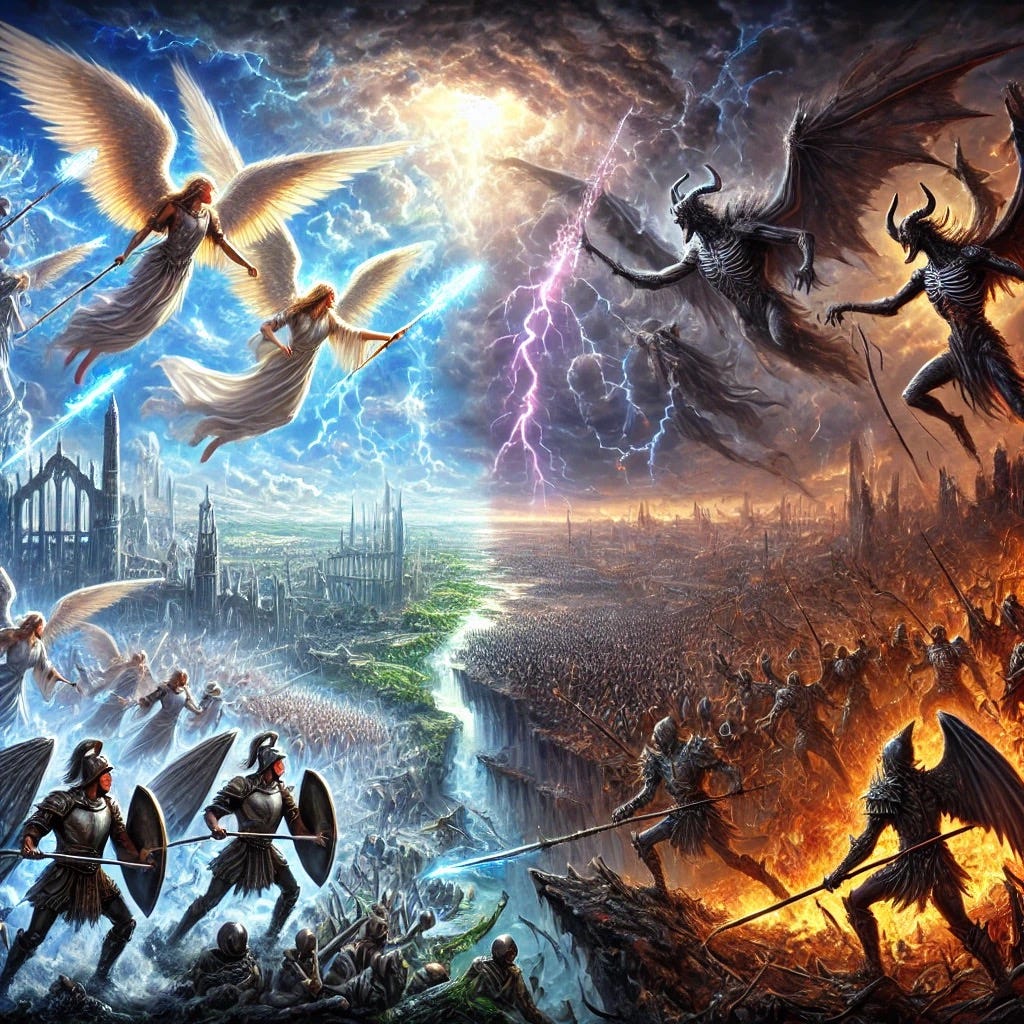The War Scroll: A Battle Between Light and Darkness
Angels in Combat: Unraveling the Cosmic Struggle
The War Scroll, one of the Dead Sea Scrolls found in Qumran, offers a vivid depiction of an eschatological war between the forces of light and darkness. This prophetic vision, central to the worldview of the Essenes, illustrates a battle at the end of time when the Sons of Light, representing the righteous followers of God, would fight against the Sons of Darkness, representing the enemies of God, including foreign nations and demonic forces. The scroll outlines strategic instructions for battle and portrays a cosmic struggle beyond mere human conflict, one involving spiritual forces and divine intervention. This apocalyptic vision profoundly reflects the Essenes’ belief that they were living in the last days, anticipating an ultimate confrontation that would usher in God’s kingdom.
The Book of Daniel and Its Influence on the Essenes
The Book of Daniel was of particular significance to the Essenes. Found among the Dead Sea Scrolls, the prophetic visions in Daniel deeply influenced their understanding of history and the final battle between good and evil. Daniel’s apocalyptic themes, such as the rise and fall of empires, the appearance of the Son of Man, and the final judgment, paralleled the cosmic battle portrayed in the War Scroll.
A key passage in Daniel that likely shaped Essene thought is the angelic interaction in Daniel 10:13, where an angel speaks to Daniel about battling the “Prince of Persia” and later confronting the “Prince of Greece.” This language implies that behind the earthly empires of Persia and Greece, there are powerful spiritual forces waging war. This idea aligns perfectly with the Essenes’ belief that behind the nations they viewed as oppressive—like Rome—there were dark, supernatural powers that would ultimately be overthrown in the coming battle of light versus darkness. For the Essenes, Daniel’s visions were not just historical reflections but divine revelations of the present and future cosmic struggle.
The Jewish Context During the Time of Christ
By the time of John the Baptist and Jesus, the Jewish people lived under the oppressive rule of Rome, a new imperial force. The apocalyptic mood present in the War Scroll and Daniel resonated with the broader Jewish population. The notion that the Romans were merely pawns in a larger spiritual war would have fit within the popular expectation of a Messiah who would deliver them from their earthly and spiritual enemies.
Jesus, too, spoke of cataclysmic events in the last days, echoing the apocalyptic tone of the War Scroll and Daniel. In Matthew 24, for example, Jesus speaks of wars, famines, earthquakes, and the ultimate battle between good and evil. He refers to the “abomination of desolation” spoken of in Daniel 9:27, indicating that Daniel’s visions remained crucial for understanding the cosmic events leading up to the establishment of God’s eternal kingdom. Jesus’ warnings about future tribulations and His portrayal of the coming of the Son of Man (Matthew 24:30) directly connected to the eschatological mood reflected in both Daniel’s visions and the War Scroll.
John’s Revelation: Revisiting the Themes of Daniel and the War Scroll
Consider John, exiled on the island of Patmos, as he writes the Book of Revelation. Guided by an angel, he revisits the theme of a cosmic battle, casting the Roman Empire as the new Babylon. The vivid imagery in Revelation closely mirrors that of the War Scroll and Daniel’s visions, as John describes spiritual warfare, angelic interventions, and the ultimate conflict between good and evil (Revelation 12:7-9). As I immerse myself in the Book of Revelation and step into John’s shoes—particularly when he depicts stars falling from heaven and locusts with stinging tails that create the sound of chariots—I can’t help but wonder if John was witnessing modern warfare in his visions.
The way missiles appear to a modern observer—streaking through the sky, trailing light and fire—bears a striking resemblance to falling stars, moving swiftly across the heavens, descending in a fiery display that captivates and terrifies. The locusts, described as having the face of a man and tails that sting, can evoke the image of modern warplanes. The “face of a man” may symbolize the cockpit, where a pilot is visible through the glass, giving the aircraft a humanoid appearance from a distance. The stinging tails might resemble missiles launched from the rear of these planes, while the mechanical whirring of engines could mirror the “sound of chariots” that John describes, making this ancient vision eerily reminiscent of contemporary air warfare. It’s easy to see how John, lacking knowledge of modern weaponry, might have interpreted such visions as celestial phenomena, describing them in the only terms available to him: stars falling from the sky and locusts with the face of a man and stinging tails. Both in Daniel and Revelation, we see the idea that behind the world’s most powerful empires, there are spiritual forces operating. This cosmic dimension of history was a shared belief between the Essenes and John. The overlap between the Book of Daniel, the War Scroll, and Revelation suggests a unified apocalyptic tradition, one in which God’s people would triumph over the forces of darkness, both on earth and in the heavenly realms.
The Essenes: Conservationists of Scripture
The Essenes played a critical role as the conservators of sacred texts, including books like Daniel. Their community at Qumran was deeply committed to studying and preserving the Hebrew scriptures, meticulously copying and safeguarding these texts. The Apostle Paul acknowledged the Jews as custodians of the Scriptures in Romans 3:2, noting, “They have been entrusted with the very words of God.” The Essenes, through their conservation efforts, may have been divinely chosen to preserve these apocalyptic writings, including the War Scroll and other prophetic books, for future generations.
One cannot help but wonder about the timing of the Dead Sea Scrolls’ discovery, just before the establishment of the modern state of Israel in 1948. The scrolls, which contain many prophecies about the end times and the restoration of Israel, were ultimately kept under the care of the Israeli state. Could the discovery of the Dead Sea Scrolls, after being hidden for so long, be seen as a divine act of preservation, resurfacing at precisely the right time to refocus the world’s attention on scripture? Something to ponder about.
Light and Darkness in the Modern World
As we consider the War Scroll’s vision of a final battle between light and darkness, we are left with the question: are we witnessing this cosmic struggle today? Are the ongoing conflicts in the world—such as the wars in Ukraine, the Middle East, and Africa—where spiritual, political, and military forces collide, raising the possibility that we are drawing closer to the apocalyptic end both John and the Essenes anticipated? With tensions escalating and nuclear threats becoming a more frequent part of geopolitical discussions, the potential for global catastrophe looms larger, reminding many of the ancient warnings about humanity’s final reckoning. Is this struggle part of the larger cosmic battle between light and darkness that the Essenes, Daniel, and John foresaw? If so, how close are we to the culmination of this great war? Love to hear your thoughts.




